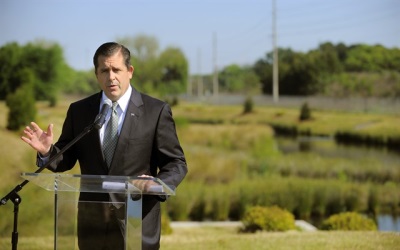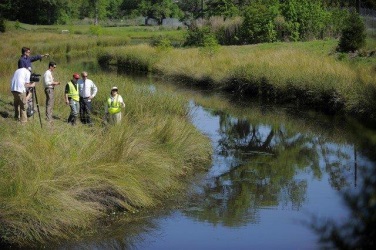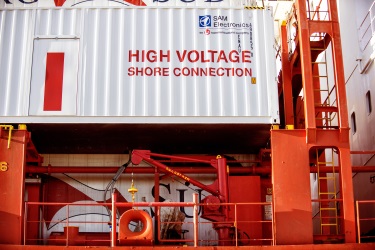
| April 29, 2014 | |
Environment: Georgia, Hueneme, Seattle, San Diego
![]() Print this Article | Send to Colleague
Print this Article | Send to Colleague
The Georgia Ports Authority (GPA) celebrated Earth Day, April 22, by dedicating nearly 14 acres of recently created wetlands. Hamburg Sud’s M/V Cap Palmerston became the first vessel to plug into the Port of Hueneme’s recently installed Grid-Based Shore Power system during an Earth Week ribbon-cutting ceremony on April 24. A pilot project designed to reduce polluted runoff reaching Puget Sound is underway at the Port of Seattle. The Port of San Diego's Green Port Program has been honored with a 2014 Green California Leadership Award.
Georgia Ports Authority Teams with Nature to Protect Water Quality

Georgia Ports Authority Executive Director Curtis Foltz speaking at the Earth Day dedication of the 14-acre wetland adjacent to Garden City Terminal in the Port of Savannah.
Photo/Georgia Ports Authority, Stephen B. Morton
The Georgia Ports Authority (GPA) celebrated Earth Day, April 22, by dedicating nearly 14 acres of recently created wetlands. The 2.5-year, $3.7 million project treats 100 million gallons of water annually and creates natural wildlife habitat in the heart of one of the busiest container terminals in the United States.
"Our mission is to grow our business in environmentally responsible ways," said GPA Executive Director Curtis Foltz. "This wetlands project is just one way we can reduce our environmental footprint while we continue to efficiently move cargo."
The new wetlands form an aquatic system composed of native vegetation including bald cypress, cord grass and soft rush. The area, located between the Mason Intermodal Container Transfer Facility and the Garden City container terminal in the Port of Savannah, supports diverse wildlife including fish, amphibians and birds, such as anhingas, great blue herons and belted kingfishers. The wetlands harness natural filtering processes to help protect water quality in the Savannah River, while also providing flood control.

An egret in flight over the newly created wetland.
Photo/Georgia Ports Authority
"We planted these wetlands with native plants, each supporting a specific aspect of stormwater filtration," said GPA Environmental Sustainability Manage Natalie Dawn. "And, in turn, those plants attract diverse native wildlife."
Ms. Dawn said the GPA’s created wetlands set a higher standard for stormwater treatment.
"The typical method in industrial environments is to build a series of concrete culverts that quickly shuttle untreated stormwater into the river," she said. "That is not nearly as effective as utilizing natural wetlands and doesn't provide animal habitat like these wetlands do."
The wetlands are part of a wider culture of environmental stewardship at the GPA that includes voluntary investments to reduce emissions, including electrifying ship-to-shore cranes and refrigerated container racks. The GPA is now set to expand its program to electrify rubber-tired gantry cranes, incorporating new machines and retrofitting others. Click here to learn more about GPA’s sustainability efforts.

GPA Environmental Sustainability Manager Natalie Dawn leading a tour of the wetland during the Earth Day celebration at Garden City Terminal.
Photo/Georgia Ports Authority/Stephen B. Morton
Hueneme Ribbon Cutting Celebrates Ship Connection to Grid-Based Shore Power System
Hamburg Süd’s M/V Cap Palmerston became the first vessel to plug into the Port of Hueneme’s recently installed Grid-Based Shore Power system during an Earth Week ribbon-cutting ceremony on April 24. The container ship was carrying fresh fruit for port tenant Chiquita Brands.
The initial test of "plugging in" a vessel is critical to assessing the performance of this new and very high voltage shore power system. It is also vital to ensuring all trained units including ILWU and ship operators become comfortable with operating the gear. The process tests the vessel’s ability to synchronize with and connect to the grid-based system. Hamburg Süd, Chiquita, Ports America, Southern California Edison, project engineers, system developers, contractors, and port technical personnel geared up to make certain all protocols were in place and the inaugural plug-in ran safely and functioned properly.
This test was a success and a second major milestone for the Port’s Shore Power system. The first was the successful load bank test in December 2013 that demonstrated the system’s capability to provide a reliable, steady source of shore power for ships at berth.
"Green is no cliché for the Port of Hueneme," said Port Commission President Mary Anne Rooney. "We take action and make environmental sustainability a top priority in our business plan to ensure we improve the quality of life and bring prosperity to the communities we serve."
Speaking on behalf of Hamburg Süd, senior vice president Mike Wilson called it "a major investment by both parties, with returns that will continue visit after visit." He spoke of his company’s efforts "to minimize our environmental impact, with fuel efficiency and energy saving measures that are achieving significant emission reductions" and applauded "Hueneme’s on-shore power connection facility" as "a big step forward in this regard."

High voltage shore power connection mounted on Hamburg Süd’s M/V Cap Palmerston.
Photo/Port of Hueneme
Moving Green Infrastructure Forward at the Port of Seattle
A pilot project designed to reduce the amount of polluted runoff reaching Puget Sound is underway at the Port of Seattle. The port is hosting a two-year study site for two unique metal boxes, which will bloom into rain gardens and help reduce pollutants. This effort is in partnership with King Conservation District, Sustainable Seattle, Gealogica LLC, and Splash Boxx LLC.
Moving Green Infrastructure (MGIF) is a research/demonstration project to test the water quality performance of two innovative stormwater treatment techniques, a large "rain garden in a box" and a special soil mix with local, volcanic sands. Water quality from a roof in an industrial port area will be tested before and after going through the boxes to see how these two techniques perform.
This research/demonstration project is part of growing efforts to reduce the amount of polluted runoff reaching Puget Sound, which is estimated to receive between 14 and 94 million pounds of toxic pollutants every year. Two large steel boxes, called Splash Boxxes, are being installed at Terminal 91. These boxes are a blend of rain garden and cistern, two practices referred to as low impact development, or LID.
The port says that information from this study will shed light on the potential for bioretention planter boxes to improve water quality of polluted runoff in commercial/industrial areas and whether soil mixes used in rain gardens and bioswales could be improved. One box will have a unique soil mix with volcanic sands and the other a typical rain garden soil mix.
The water going into each box from the roof runoff will be tested once a month during the rainy seasons for phosphorus, nitrogen, bacteria, zinc, and copper. Splash Boxxes are part of an innovative stormwater research and demonstration project funded by King Conservation District and managed by Sustainable Seattle through a contract with Gealogica LLC. The Port of Seattle is providing the site for two years. Click here for more project details.
San Diego Honored with Green California Leadership Award
The Port of San Diego's Green Port Program has been honored with a 2014 Green California Leadership Award. The award was presented at an April 8 reception as part of the Green California Summit, an annual conference that highlights the wide range of policies, programs, strategies and technologies that are being implemented to preserve California's natural resources.
The award was presented in the Green Economic Development category, which recognizes sustainability measures that also promote economic growth.
Established in 2008, the Green Port Program includes initiatives that help the port and its tenants conserve water and energy, decrease their waste and reduce emissions around San Diego Bay. The Green Port Program was commended by the Green California Leadership Award for its sustainability initiatives that not only include port operations, but the operations of port tideland businesses. One particular effort recognized was the Port's Climate Action Plan.
The board of port commissioners adopted the Climate Action Plan in December 2013. The plan identified six Green House Gas emission reduction categories, including transportation and land use, energy conservation and efficiency, alternative energy generation, water conservation and recycling and waste reduction and recycling.
The Climate Action Plan will receive a comprehensive review every three years to measure its effectiveness. The port plans on moving forward with a second part of the plan, which incorporates climate change, within the next several months.
